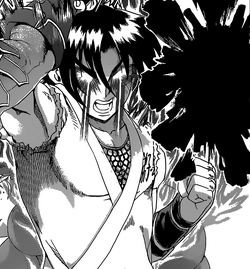|
This article, Genkai Kikyaku, was added by Seireitou who determines its usage on this wiki. |
| Genkai Kikyaku | |
|---|---|

| |
| Kanji | 限界棄却 |
| English | "Limit-Abandoning" |
| Technique Statistics | |
| Type | Hakuda |
| Users | Humans, Souls |
- "If you're facing an opponent that can't be defeated by your actual self, visualize in your imagination a self that can defeat him."
- —Seireitou describing the nature of the Genkai Kikyaku.
Genkai Kikyaku (限界棄却, "Limit-Abandoning") is a Hakuda technique of the Shōin Shiranui Style, centered within the realm of Kiroku, that was developed by Seireitou Kawahiru. Among the Shikon techniques of the aforementioned martial art, it represents the spirit of Aramitama.
Overview[]

Shattering through one's current limits.
The entire basis of Kiroku is the act of taking in the "Ki" of something that a martial artist observes, whether that be another person, an aspect of nature, or even a concept, and drawing power from that Ki by altering their own Ki to that form. When the Ki is perceived as that something, it becomes that thing; in essence, the deception becomes real. According to Seireitou, the Genkai Kikyaku is the "ultimate deception of the self". It does not actually adopt the Ki of something that exists but rather something that can exist. Specifically, the technique calls for the martial artist to visualize a self that is stronger than the current self they are, constructing in their minds the feeling such a power would be, and through Kiroku, they adopt that visualized Ki as their own, turning themselves into that stronger self. In relation to Seireitou's statement, rather than a deception imposed on an opponent, it is a deception cast on the self. In order to accomplish such a thing demands a sufficient mastery over the first realm, Kiai, as it can only be performed by a martial artist that can intimately understand their limits and the full scope of their current level. They must be a martial artist that never doubts their capacity for growth and the potential that they can reach, because for the visualization to become authentic enough that they believe it to be true, it must exist as an indomitable truth in the center of their mind, body, and soul.
When performing the Genkai Kikyaku, the user's body becomes consumed in a powerful aura that either replaces or layers over their normal spiritual pressure, often resulting in a different or dual-nature reiatsu. Their eyes produce an intense bioluminescence that completely blanks out their irises. How successful the Genkai Kikyaku is upon execution is dependent on how realistic a self the martial artist visualizes. In most cases, the user initially performs the technique by imagining a self that is twice as strong as their current self, causing their power to become augmented by double. Subsequently, the typical progression by the Genkai Kikyaku user is set in these intervals of double, triple, and so on, until they are unable to genuinely maintain a visualization. The intensity of the reiatsu, as well as the emission of light by the eyes, produced by the technique often increases based upon how much the greater the augmentation that the martial artist aspires to unleash.
Of course, such a technique is not without its drawbacks. No matter how perfect a martial artist may have mastered Kiroku, they are still performing a technique that actively abandons their limits to aspire to greater power, thereby pushing themselves beyond what they should be capable of doing. Such an act imposes a tremendous strain on the body, making the Genkai Kikyaku a technique that is ideally only performed in short bursts, and even then, one is advised not to push the technique too far as the degree of strain is proportional to how great the difference is between the current self and the heights that the martial artist seeks to reach through the technique.
Applications[]
Known Users[]
Behind the Scenes[]
This technique was inspired by the Kaiōken in the anime and manga series, Dragon Ball.
